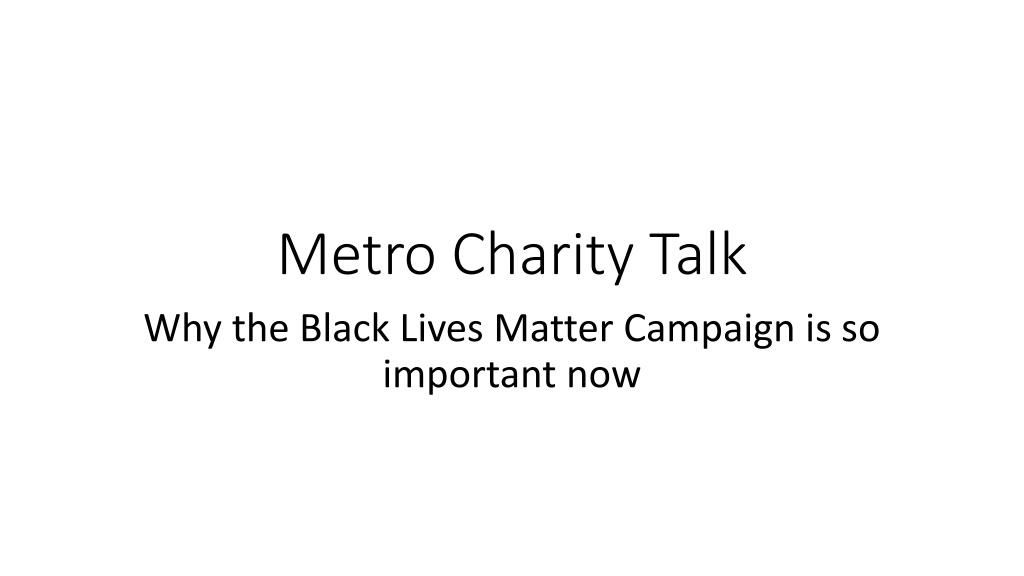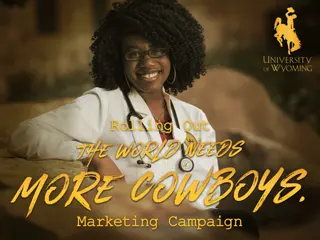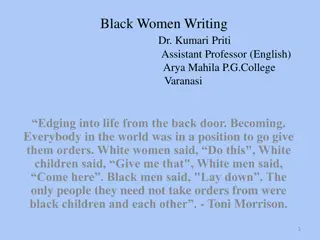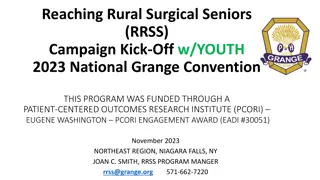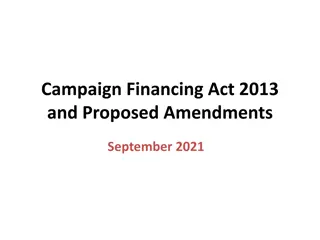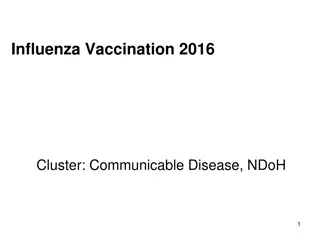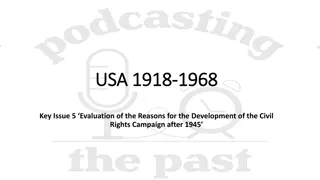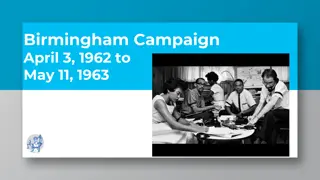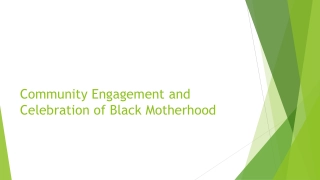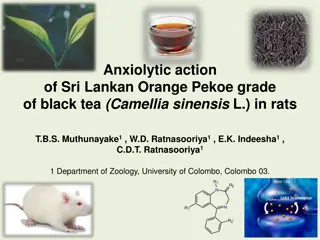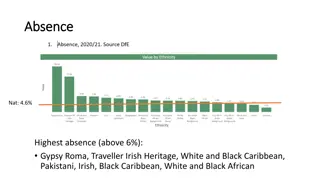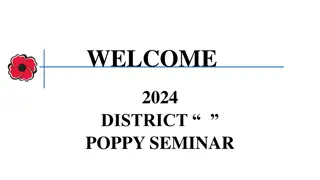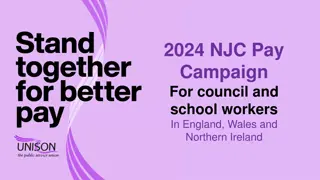Why the Black Lives Matter Campaign is Crucial in Today's Society
The Black Lives Matter campaign stands as a vital movement addressing systemic racism and discrimination. With a focus on social justice and equality, this initiative aims to bring about change and support for marginalized communities. Its relevance is underscored by the need for inclusivity, anti-racism, and advocacy for racial equity.
Download Presentation

Please find below an Image/Link to download the presentation.
The content on the website is provided AS IS for your information and personal use only. It may not be sold, licensed, or shared on other websites without obtaining consent from the author. Download presentation by click this link. If you encounter any issues during the download, it is possible that the publisher has removed the file from their server.
E N D
Presentation Transcript
Metro Charity Talk Why the Black Lives Matter Campaign is so important now
JO Background: Long-standing interest in anti-racist and E&D work going back to work in the community/NVS sector as a black activist local and national work Social work AOP, understanding of social movement in driving E&D & Involvement
Patient champion- Driven by a personal tragedy, Josephine Ocloo campaigns to give a voice to those who feel they have been wronged by the medical profession and to make healthcare in Britain safer. Mark Gould reports. The Guardian Wednesday June25, 2008 Josephine Ocloo: "I have lost my child in horrendous circumstances under an organisation that was supposed to be caring for her." Photograph: Teri Pengilley 5
Published Papers on PPI in Patient Safety & Quality: Ocloo, J, Goodrich, J, Tanaka, H, Birchall-Searle, J, Dawson, D, Farr, M. The importance of power, context and agency in improving patient experience through a patient and family centred care approach. Health Research Policy and Systems. 2020.18:10. Ocloo, J & Matthews, R. From tokenism to empowerment: progressing patient and public involvement in healthcare improvement. BMJ Qual Saf 2016 0:1 7. Ocloo, J (2013) How FT governors can improve patient safety. London Health Service Journal. Ocloo, J.; O Shea, A.; Fulop, N. (2013) Empowerment or Rhetoric?: Investigating the role of NHS Foundation Trust Governors in the governance of patient safety Health Policy: Vol 111(3):301-310 Ocloo, J. & Fulop, N. (2011) Developing a 'Critical' Approach to Patient and Public Involvement in Patient Safety in the NHS: Learning Lessons from other parts of the Public Sector? Health Expectations June 2011. Ocloo, J. (2011) 'Broadening the Patient Safety Movement: Listening, Involving & Learning from Patients & the Public'. In Rowley, C.A. & Waring, J. (eds) Socio-Cultural Perspectives on Patient Safety. Surrey: Ashgate publishing Ocloo, J. (2010) Harmed patients gaining voice: Challenging dominant perspectives in the construction of medical harm and patient safety reform. Social Science & Medicine. 71, 510-516.
ARC South London ARC South London We are a research organisation that brings together researchers, health and social care practitioners, and local people to improve health and social care in south London
The core members of the NIHR ARC South London collaboration are: The core members of the NIHR ARC South London collaboration are: NHS Foundation Trusts: King s College Hospital NHS Foundation Trust (host trust) Guy s and St Thomas' NHS Foundation Trust South London and Maudsley NHS Foundation Trust St George's University Hospitals NHS Foundation Trust Academic networks: Health Innovation Network (Academic Health Science Network for south London) King s Health Partners (Academic Health Science Centre for south London) Universities: King s College London Kingston University St George's, University of London We also work with a range of local and national charities, health commissioners, local authorities, and community organisations in south London.
ARC South London has seven core areas of research. They are: ARC South London has seven core areas of research. They are: alcohol tackling the impact on public health from harmful drinking children and young people improving care for children with complex needs and disabilities maternity and perinatal mental health addressing health inequities among women from vulnerable groups palliative and end of life care improving the quality, availability and cost- effectiveness of palliative care patient and public involvement (PPI) research understanding and strengthening PPI practice in health and social care public health and multimorbidity understanding and developing interventions to address multimorbidity social care understanding the value of day services for people with multiple complex conditions.
ARC South London has seven core areas of research. They are: ARC South London has seven core areas of research. They are: alcohol tackling the impact on public health from harmful drinking children and young people improving care for children with complex needs and disabilities maternity and perinatal mental health addressing health inequities among women from vulnerable groups palliative and end of life care improving the quality, availability and cost- effectiveness of palliative care patient and public involvement (PPI) research understanding and strengthening PPI practice in health and social care public health and multimorbidity understanding and developing interventions to address multimorbidity social care understanding the value of day services for people with multiple complex conditions.
Current Research Involvement: Current Research Involvement: Current sit on the MH Equalities Taskforce/PCREF at NHS England & NHS Improvement Mental Health loneliness/isolation in the pandemic Needs/Services for those with Complex Emotional needs linked to PD Developing a broader patient harm definition in patient safety Grant Ethnic inequalities in mortality and service use in people with mental disorders and multimorbidities during the COVID-19 pandemic: Mixed methods study
Covid Covid- -19 Mortality in the UK 19 Mortality in the UK Stark disparities in mortality rates/health inequalities for particular groups: e.g. BAME communities, disabled people, those on lower incomes, those living in the most deprived areas, care home residents, and those in the poorest health etc. These groups already face considerable inequalities in health which may now get much worse. People from a black ethnic background are at the greatest risk of death involving Covid-19 than all other ethnic groups. black men 3 times more likely than white men to die & black women more than twice as likely to die as white women (ONS June 2020). Adjusting for socio-economic factors/geographical location, partially explains the increased risk, but there still remains twice the risk for black males after this & around one & half times more risk for black females (ONS June 2020).
Institutional Racism Institutional Racism Black people have long been more likely to enter mental health services through emergency/criminal justice systems, more likely to be in psychiatric intensive/medium secure units, more likely to be secluded/physically restrained. Racially based social/economic disadvantages are at the root of ethnic differences Forensic psychiatry is seen as the area racial injustices are most acutely felt. complex, coercive & adverse pathways, into, through & out of mental healthcare faced by black people, with poorer access to effective interventions/poorer outcomes . In considering the implications of psychiatric diagnosis & (often aggressive) treatment for the life-course of the patient, Nazroo asks does the maxim of Do no harm actually hold? [Nazroo 2015 & 17]
BAME Women & Maternity Black women have more than five times the risk of dying in pregnancy or up to six weeks postpartum compared to white women, women of mixed ethnicity three times the risk and Asian women almost twice the risk (MBRRACE-UK 2019). Mortality rates also remain high for Black or Black British and Asian or Asian British babies. Whilst stillbirth rates for these groups have reduced over the period 2015 to 2017, conversely neonatal mortality rates have increased over the same period (MBRRACE Perinatal Mortality Report 2019).
Community Zoom event: Community Zoom event: Pregnant women facing fear/isolation: Concerns raised by Doulas, about verbal/ emotional abuse of some BAME women perceived to be driven by racist attitudes* BAME groups with higher risks from the virus, fearful of attending outpatients/hospital with other symptoms/going to get medication/blood tests/high levels of distrust in health system People with disabilities/learning difficulties worried about discrimination/whether they would be treated fairly in terms of access to resources/ventilators Digital exclusion preventing many vulnerable people accessing primary care/benefits Loss of face-to-face services/detrimental impact on MHSU s: e.g. /BAME/LGBT+ groups have higher rates of poor MH/worse access, closure of services have a particular impact
Being heard, not, seldom heard: democratising research with diverse Being heard, not, seldom heard : democratising research with diverse communities during the Covid communities during the Covid- -19 pandemic. 19 pandemic. Opening up a broader debate about democratising the whole research process, rather than just D&I in PPI, which is much narrower. Debates in GHR talk about moving away from semi-colonial approaches which serve the interests of populations in high income countries/the need to have more equitable research partnership addressing high mortality/morbidity rates in poor/ middle income countries. These debates raise questions about democratising research in the UK, particularly in the pandemic & about who benefits from research/how it addresses the needs of groups facing the worst health inequalities.
Key Points from BMJ Piece Groups facing the worst inequalities often the least likely to be involved in the design/implementation of research. This reflects wider patterns of public sector involvement which show that those most likely to be involved are older, from white ethnic groups, and higher socio-economic backgrounds. This context exists despite long-standing calls for more equal partnership models to involve diverse groups in research and healthcare practice. Need for more participatory/co-produced and action research types methodologies in research
Developing D&I in ARC South London Work: Making D&I a standing item on all boards and committees. Adding D&I to the terms of reference of boards/committees. Exploring how broader community representation of individuals/groups can be achieved on ARC boards/committees. Ensuring all projects include considerations of D&I. Ensure all themes (main/cross-cutting) complete D&I Achievement Logs (to identify good practice/areas of improvement/monitor progress]. Further thought should be given to addressing issues of under-representation of research participants in research themes, especially from BAME, disability and LGBTQ+ groups. Exploring how staff from under-represented groups are able to input at a strategic level into the work of the ARC.
